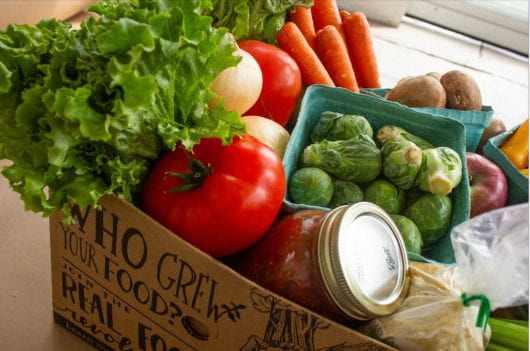
University Dining Services provides cooking advice to students in quarantine. Credit: Courtesy of Yellowbird Foodshed
Staying at home might be dulling students’ minds, but they can sharpen their knives and cook away the quarantine blues.
With concerns around COVID-19 moving most students out of residence halls and closing dine-in areas of restaurants across the country, Ohio State students may be getting their hands dirty — and then washing them — in the kitchen for the first time. Ohio State’s Office of Student Life University Dining Services has advice for students looking to channel their inner Gordon Ramsey.
“When we try and talk to our students about how to build a plate, we find one of the most effective ways is to say at least half of your plate should be fruits and vegetables,” Lesa Holford, corporate executive chef for Dining Services at Ohio State, said.
When it comes to those fruits and vegetables being fresh, frozen or canned, Gina Forster, assistant director of nutrition for Dining Services, said the nutritional differences are minimal. Forster said the only drawback to canned vegetables is higher sodium levels, which can be reduced significantly by rinsing them out in a strainer.
“You can make an argument that frozen vegetables have more nutrients — I don’t want to say healthier, I don’t like that word — but maybe a little bit more nutrient dense, because they are flash frozen right after harvest,” Forster said. “But I always say no matter how you get your vegetables, you’re better off getting them than worrying about whether they’re fresh, frozen or canned. Just get them in your diet.”
There are many ways to go about preparing vegetables for a meal, but Forster said she likes to keep it simple.
“What I like to do with raw vegetables is simply chop them up, throw them on a pan with a little bit of olive oil, salt and pepper, and roast them. I feel like roasted vegetables have some of the best flavor – the best way to get good flavor out of a vegetable bar none in my opinion,” Forster said.
Forster said protein and milk are also important food groups, but they don’t necessarily need to come from meat or dairy.
“[Vegans] need to make sure they’re getting enough calcium and vitamin D in their diets, which they can find in their milk substitutes – almond milk, soy milk, whatever they choose to drink instead of dairy cow’s milk,” Forster said.
She said whole grains such as quinoa, wild rice, legumes, lentils and nut butters are good sources of protein, as well as veggie burgers and nuggets. Iron can be a nutrient of concern for vegetarians and vegans, Forster said, but it can be found in beans or dark, leafy greens such as kale and spinach in addition to red meat.
When it comes to cooking, Forster said the most important things are cooking food at the proper temperatures. Safe minimum cooking temperatures for different meats can be found at foodsafety.gov.
Forster said washing your hands frequently throughout the cooking process is also essential.
“Especially now, with the virus, it’s even more important to wash your hands, but it’s definitely important to wash your hands between meat and poultry and eggs and fresh produce,” Forster said.
Holford said that while restaurants are still offering takeout meals, students can easily augment them with fresh fruits or homemade salads. She added that cooking simple meals at home can also be very cost effective.
“The other day, I just roasted chicken legs on a rack over sliced carrots and torn up sourdough bread that I covered so that the bread got all nice and crouton-y, and the carrots caramelized, and the chicken got all crispy … It was one of those dinners that could feed a family of four and it probably cost $6,” Holford said.
Holford added that soups are also a good way to add protein to a student’s diet, make for good leftover meals and save money.
“I think that soups are an excellent thing if you have the time to be slicing, dicing and chopping your carrots, celery, and onions, and adding some beans and a little bit of protein,” Holford said. “That’s a super way to make, also, a large batch of something that you can eat more than once that’s very cost effective.”
Forster said she is a fan of one-pot and slow-cooker dishes, and there are plenty of recipes online.
“My main goal is to make sure that people are enjoying the food that they eat. That is my No. 1 goal, followed by making sure that it’s balanced,” Forster said. “Because if it’s not something they’re actually enjoying eating, it’s not something that they’re going to be able to sustain. So what is the point?”


